279: China - 21st Century Realism
07-18-2009
 PropertyInvesting.net team
PropertyInvesting.net team
Explosion in Cars and Oil Consumption: China has a population of 1.5 billion people. It has 25 million cars. By 2050 the IMF has forecast that the number of cars will rise to 525 million. That’s only one car for every three people, far less than the 1 for every 1.5 that Italy has for example. We have performed some analysis on the implications of this increase in car usage for China’s oil consumption. Even assuming that by 2050 about 50% of cars are electric powered, instead of China burning 1 million barrels of oil a day for car diesel and petrol fuels, China would instead require a massive additional 10 million barrels of oil a day to feed the fuel requirements of these cars. A ten fold increase in oil usage even assuming half are electric powered. If no cars are electric, then 20 million barrels of oil a day would be required. The total 10.5 million bbls/day is still far less oil than the USA currently imports. To put this into context, global oil production currently stands at about 84 million barrels a day. We believe Peak Oil was July 2008 – and we are on a bumpy plateau for a few years before oil production starts a terminal decline. Where will this additional 10 million barrels a day come from? It will have to come from declines in other oil importing nations. This points towards far higher oil prices in years to come.
China Cars - Forecast Increase in number of cars (note: June 2009 car production increase 37% over 2008 levels) - from 25 million to 500 million by 2050
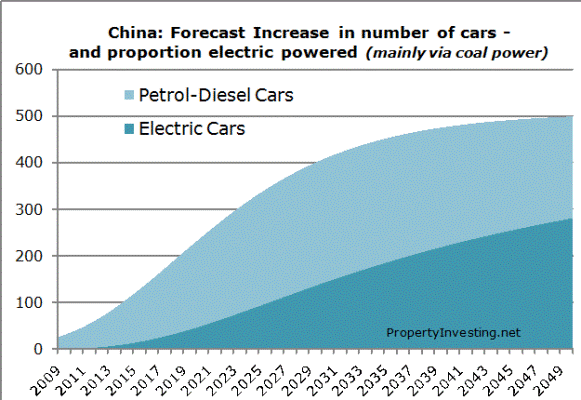
China Oil Consumption Increase Due to Petrol Diesel Cars (consumption of crude oil for car fuel increases from 1 million bbls/day to 10.5 million bbls/day then drops slightly to 8.4 million bbls/day by 2050 as electric car numbers increase)
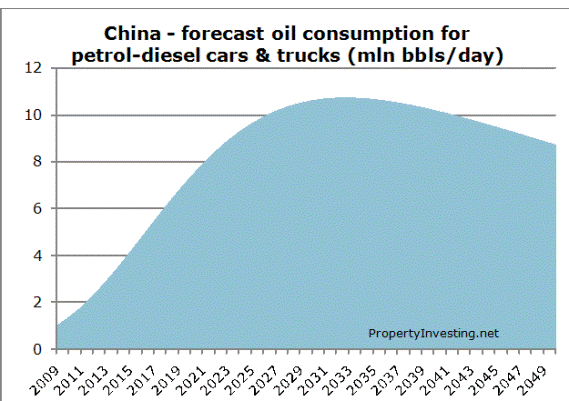
Electricity means Coal: Of course if there is a big increase in elec
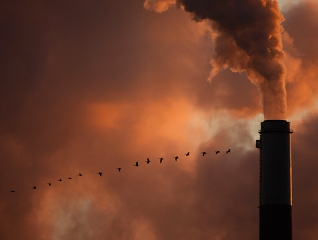 tric cars, the electric power will need to come from somewhere – and you guessed it – let’s be realistic – the bulk of it will come from coal burning power plants. This is not what the environment needs – because of additional CO2 emissions – but to think any different is probably being unrealistic. Options exist for hydro-electric power but this has been unpopular with environmentalists in the past (Seven Gorges Dam as an example). Options exist for nuclear – ditto. Options exist for gas, but global Peak Gas is expected in ca. 2015 so this will not help in the long term. Options exist for wind, but China is not very windy. Options exist for solar – better option than most, but very expensive and takes a lot of land which is needed for food. Options exist for bio-fuels – but this land is required for food production. One can see, we just go around in circles – until it comes back to coal and increasing CO2 levels. There is a panacea out there, but realistically – if electric car numbers start booming – most of this electricity will come from coal. Particularly as China has some of the largest coal reserves in the world – will China let these reserves sit there? We think the answer is – no. As mentioned, this will contribute to CO2 emissions and global warming - it is realistically unlikely other countries CO2 declines and offsets will be enough to prevent an overall global CO2 increase - despite most government's best intentions. Technology and energy efficiency can help, but it is all getting very late in the day - too little, too late - a global recession does not help with investment in efficiency either, or switches to other energy forms. Green Tech investment is far lower in 2009 than it was in 2008 as an example - a worrying trend.
tric cars, the electric power will need to come from somewhere – and you guessed it – let’s be realistic – the bulk of it will come from coal burning power plants. This is not what the environment needs – because of additional CO2 emissions – but to think any different is probably being unrealistic. Options exist for hydro-electric power but this has been unpopular with environmentalists in the past (Seven Gorges Dam as an example). Options exist for nuclear – ditto. Options exist for gas, but global Peak Gas is expected in ca. 2015 so this will not help in the long term. Options exist for wind, but China is not very windy. Options exist for solar – better option than most, but very expensive and takes a lot of land which is needed for food. Options exist for bio-fuels – but this land is required for food production. One can see, we just go around in circles – until it comes back to coal and increasing CO2 levels. There is a panacea out there, but realistically – if electric car numbers start booming – most of this electricity will come from coal. Particularly as China has some of the largest coal reserves in the world – will China let these reserves sit there? We think the answer is – no. As mentioned, this will contribute to CO2 emissions and global warming - it is realistically unlikely other countries CO2 declines and offsets will be enough to prevent an overall global CO2 increase - despite most government's best intentions. Technology and energy efficiency can help, but it is all getting very late in the day - too little, too late - a global recession does not help with investment in efficiency either, or switches to other energy forms. Green Tech investment is far lower in 2009 than it was in 2008 as an example - a worrying trend.
Aspiration to own a Car: Some people may say that the Chinese will need to st op or slow down building cars. But let’s be realistic – do we really think this will happen? China is a massive country with many indigenous Chinese and other races – to help provide political and social system cohension – we believe the country will need to provide economic prosperity for the population. This means jobs, improving standards of living, electricity, housing, food, water, education, health and.....cars. Just like the USA in the 1950s and UK in the 1960s. Chinese aspire to own and drive cars just like people currently do in western countries. Cars are a signal of wealth, success, freedom and prestige for people all around the world (regrettable though this may be) – this human behaviour is no different in the USA, Kenya, Korea, Iran or Chile - to think almost all the 1.5 billion Chinese people will not want access to a car is rather unrealistic. They will want cars to travel to work, go on holiday, do the shopping - just like every other car owner in the world.
op or slow down building cars. But let’s be realistic – do we really think this will happen? China is a massive country with many indigenous Chinese and other races – to help provide political and social system cohension – we believe the country will need to provide economic prosperity for the population. This means jobs, improving standards of living, electricity, housing, food, water, education, health and.....cars. Just like the USA in the 1950s and UK in the 1960s. Chinese aspire to own and drive cars just like people currently do in western countries. Cars are a signal of wealth, success, freedom and prestige for people all around the world (regrettable though this may be) – this human behaviour is no different in the USA, Kenya, Korea, Iran or Chile - to think almost all the 1.5 billion Chinese people will not want access to a car is rather unrealistic. They will want cars to travel to work, go on holiday, do the shopping - just like every other car owner in the world.
Resources and Commodities Bing: Hence China – as we are no doubt aware – is into a massive programme to gain access to raw materials to fuel this expanding economy. If the economy expands by 10% a year, raw materials consumption will expand by between 5% and 10%, possibly more. Anyone that thinks a recession in the USA will stop this relentless economic expansion is again being unrealistic. Whilst most western economies will see GDP recessions of between -2% and -7% this year, China continues to grow at a rate of +7.8%. That’s 15% higher than some western countries! What it demonstrates is that China (like the USA used to be in the 1980s) is a huge economic engine that is relatively well insulated  from external forces – the increase in consumerism in China and internal trade within its regions and within Asia Pacific with its trading partners has seen its economic growth slip by only 4% - from 11.8% to 7.8% in the last year despite the biggest global recession for decades. China will remain the growth engine of the global economy – along with India and Brazil for years to come.
from external forces – the increase in consumerism in China and internal trade within its regions and within Asia Pacific with its trading partners has seen its economic growth slip by only 4% - from 11.8% to 7.8% in the last year despite the biggest global recession for decades. China will remain the growth engine of the global economy – along with India and Brazil for years to come.
So what are the implications for western nations? Firstly, expect to see raw material prices rise and competition for commodities to increase further – namely oil, gas, coal, wood, food and metals. Because of China’s very low wages, it can afford to spend more on raw materials to keep it's factories going strong. This will mean western nations will see higher prices, higher inflation, less disposable income, larger deficits and lower annual GDP growth rates. In summary, higher commodities prices will act as a drag on western economies - like a tax – except to those that export oil, gas, coal and metals such as Norway, Canada and Australia. USA would be in a good position if only it did not import 10 million barrels of oil a day! (that’s a whopping import bill of $356 Billion a year at $100/bbl – dollars leaving the country). The worrying trend is how left leaning governments in western countries have increased taxes and massively expanded the public sector to an extent that any additional commodity price increase (rememeber this acts like an additional tax) zaps the economy and send the country into recession. Further to this, we believe the underlying cause of the current western recessions was the high commodities prices end 2007 to July 2008 (most commodities increased 5 to 10 fold in 8 years). This is just like the recessions of 1973, 1981 and 1991 - all cause by massive spikes in oil prices and Trillions of dollars a year passing from western oil importing nations to OPEC and oil exporting nations. Thence mst of this money going on social spending (health, free energy, zero tax, subsidized fuel, public sector jobs). One has to ponder where the wealth in the private sector is being created when it's been sufficated so severely by increased in tax, public sector, regulations and high commodities costs - no wander there's been a recession!
So what does China this mean for the property investor? Higher inflation is not good news, because interest rates rise, mortgage rates rise and people feel the pinch – thence asset prices decline – and property prices decline. The only sure and safe way of hedging against this is to property invest in countries and cities that are exposed to high commodities prices:
· UK: London and Aberdeen
· Norway: all cities, towns and villages
· Canada: all cities and towns
· Australia: all cities
· Russia: all cities, towns and villages – particularly Moscow and St Petersburg
· USA: Houston, Dallas, Wyoming, areas of Shale Gas drilling expansion
· Holland: The Hague
· Switzerland: Geneva
· Monaco (tax haven)
Threats: Conversely – avoid investing in countries, cities and towns heavily exposed to Peak Oil and 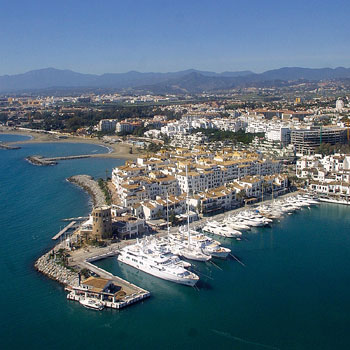 rising commodities prices that import almost all their commodities, have high wage costs, high taxes, declining populations, aging populations, at rise to global warming (droughts, lack of water, rising food costs) and are not renowned for manufacturing, banking or industrial prowess:
rising commodities prices that import almost all their commodities, have high wage costs, high taxes, declining populations, aging populations, at rise to global warming (droughts, lack of water, rising food costs) and are not renowned for manufacturing, banking or industrial prowess:
· Italy
· Portugal
· Spain
· Greece
China Investing: The most direct way to benefit from China’s economic expansion is to purchase property in China. However, there are many pitfalls and restrictions on foreign ownership. For individual entrepreneurs be careful of property investment funds without a track record – high management fees and poor performance with insecure control of investment are some of the pitfalls. A remember, to get a good deal in China is a challenge to put it mildly - expect a tough negotiation!
Investment Opportunity Areas: In summary, we believe the rise of China as an economic powerhouse has only just begun. And in 25 years time, as long as the Chinese government can keep the security and peace within the country, this economy will be five to ten times bigger and be drawing on all commodities around the world.
If you want to invest with this in mind, look no further than the following sectors:
· Oil and gas exploration, development and production
· Coal exploration, development and production
· Metals exploration, development and production
· Electric battery manufacturers
· Green-tech (wind, solar, algal biodiesel)
· Forestry – land
· Energy and water conservation and efficiency services
· Companies specializing in food yields, productivity and agricultural efficiency
· Agriculture – land
Worried About Food? For all those worried that there will not be enough food to eat with the rise in global population from 7 Billion today to 9 Billion by 2050, consider this. Every 1 kg of meat takes 8 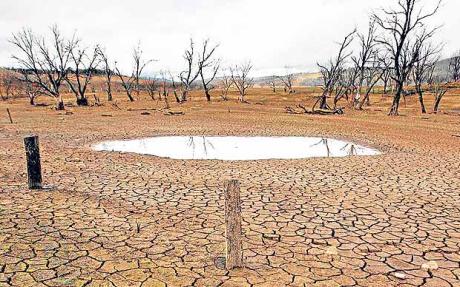 kg of grain (or food) to produce it. So if food starts running short, the world needs to start a “stop meat” programme! If we could convert even a fraction of the land used for grazing beef, lamb, pigs etc to growing gain, then there would again be plenty of food. Those knowledgeable on the subject of “Peak Oil” will remonstrate pointing to grain production being very oil intensive, and we would agree with this. The trick will be to produce grain with as little oil as possible, preferably locally to the market or consuming population. Advances is food science, yields and farming techniques will help – developing grains that require less water and fertiliser will be key. All these are required to keep food prices down and help the poorest countries and populations around the world, particularly with the threat of global warming, water shortages and drought ever present. Expect in the next 10-20 years that more marginal and cattle grazing land will be converted to arable land as grain prices rise. And don’t be surprised if the governments around the world start taxing meat consumption in view of the massive amounts of oil it requires to produce a kilogram of meat – food for thought – no pun intended!
kg of grain (or food) to produce it. So if food starts running short, the world needs to start a “stop meat” programme! If we could convert even a fraction of the land used for grazing beef, lamb, pigs etc to growing gain, then there would again be plenty of food. Those knowledgeable on the subject of “Peak Oil” will remonstrate pointing to grain production being very oil intensive, and we would agree with this. The trick will be to produce grain with as little oil as possible, preferably locally to the market or consuming population. Advances is food science, yields and farming techniques will help – developing grains that require less water and fertiliser will be key. All these are required to keep food prices down and help the poorest countries and populations around the world, particularly with the threat of global warming, water shortages and drought ever present. Expect in the next 10-20 years that more marginal and cattle grazing land will be converted to arable land as grain prices rise. And don’t be surprised if the governments around the world start taxing meat consumption in view of the massive amounts of oil it requires to produce a kilogram of meat – food for thought – no pun intended!
 Conservation Leads to Consumption: This sounds rather contrarian, but we'll give you an example in the current context of China cars. As fuel efficiency has improved - the size of cars has doubled! Sounds absurd but its the reality. A case in point - back in the late 1960s, a 1.3 litre 50 BHP Triumph Herald was an average car in the UK. They made the MG Midget, a 1.1 litre Sports Car! MGs also sold well in the USA - California in particular at this time. Now the average car has a 2 litre turbo changed engine, is 160 BHP and is more than double the size! It’s not uncommon to see 4 litre BWM 4x4 or Toyota that look like lorries and are taller than a man – driving around the same narrow city streets
Conservation Leads to Consumption: This sounds rather contrarian, but we'll give you an example in the current context of China cars. As fuel efficiency has improved - the size of cars has doubled! Sounds absurd but its the reality. A case in point - back in the late 1960s, a 1.3 litre 50 BHP Triumph Herald was an average car in the UK. They made the MG Midget, a 1.1 litre Sports Car! MGs also sold well in the USA - California in particular at this time. Now the average car has a 2 litre turbo changed engine, is 160 BHP and is more than double the size! It’s not uncommon to see 4 litre BWM 4x4 or Toyota that look like lorries and are taller than a man – driving around the same narrow city streets  used by horse and cart in Victorian times. Then there are the “space wagons” or people carriers with no people in them that just seem to get bigger every year. Car parkings places in the UK no longer have spaces that fit these gigantic cars. In the USA, cars have been replaced by Trucks - these monsters of the road commonly have 5 litre V8 engines and do 18 mpg - fuel consumption per car has not improved in 40 years, but the power and size of engines and cars had doubled. By the way, the Hummer on the right is the small version! And the smaler car it had a accident with has a 6 litre V8 engine that does 15 mpg. Regrettably, one reason why people drive such big cars is as a defensive measure against other huge cars and trucks driving around! But for cyclists and pedestrians - be careful - any wander why one sees so few people walking along the streets with such monsters dashing around.....going back to China, just image if there were 500 million trucks like this on the roads. of course China knows it will need smaller more efficient cars, but there will still be plenty of wealthy people who will want to drive large cars and trucks no doubt.
used by horse and cart in Victorian times. Then there are the “space wagons” or people carriers with no people in them that just seem to get bigger every year. Car parkings places in the UK no longer have spaces that fit these gigantic cars. In the USA, cars have been replaced by Trucks - these monsters of the road commonly have 5 litre V8 engines and do 18 mpg - fuel consumption per car has not improved in 40 years, but the power and size of engines and cars had doubled. By the way, the Hummer on the right is the small version! And the smaler car it had a accident with has a 6 litre V8 engine that does 15 mpg. Regrettably, one reason why people drive such big cars is as a defensive measure against other huge cars and trucks driving around! But for cyclists and pedestrians - be careful - any wander why one sees so few people walking along the streets with such monsters dashing around.....going back to China, just image if there were 500 million trucks like this on the roads. of course China knows it will need smaller more efficient cars, but there will still be plenty of wealthy people who will want to drive large cars and trucks no doubt.
IT Reducing Energy: 25 years ago, people predicted incorrectly that IT would lead to home working, less travel and reducing energy consumption. However, instead of people living close to their work and travelling by train, IT has allowed people to live far further from their work, and spend about 3 days in the office a week instead of 5 - some called telecommuting. But instead of a 20 minute journey, they will now travel 2-3 hours or catch a plane and still commute from a pied-de-terre property. Meanwhile, the amount of electricity consumed by IT servers has doubled since 2005. IT computing speeds and capacity has sky-rocketted - and along with it - energy consumption. In the USA. the increase in energy used by these servers is the same as pumped out from 14 big power stations. As more and more of the 7 Billion  population get hooked up to the PC and Internet, expect electricity consumption to skyrocket. This will of course put further strain on energy resources and infra-structure. To think electricity consumption will level off is totally unrealistic as developing countries industrialise - IT, services, cars, lighting, heating, air conditioning. It will all require huge power increases. So the talk of global CO2 reductions is also unrealistic much as we would all love to see it happen. And yes, it will lead to further global warming and likely sea-level rises. To think wind and solar power will have any appreciable impact on the overall levels of CO2 being emitted is probably optimistic. Global Warming Conferences being performed via video-conference would send a positive message. Tax on aviation fuel and beef would also help. And tax-breaks on private sector Green Tech and property energy conservation. Simple things like painting roofs white in hot countries (cools and saves aircon usage) and black on cold countries (warms and saves heating usage) would also help conserve energy. But all that said, can you think of one person who would not like to live in a mansion like the one above. And most people are prepared to cut back on non essentials to pay for their (large) homes and (large) cars.
population get hooked up to the PC and Internet, expect electricity consumption to skyrocket. This will of course put further strain on energy resources and infra-structure. To think electricity consumption will level off is totally unrealistic as developing countries industrialise - IT, services, cars, lighting, heating, air conditioning. It will all require huge power increases. So the talk of global CO2 reductions is also unrealistic much as we would all love to see it happen. And yes, it will lead to further global warming and likely sea-level rises. To think wind and solar power will have any appreciable impact on the overall levels of CO2 being emitted is probably optimistic. Global Warming Conferences being performed via video-conference would send a positive message. Tax on aviation fuel and beef would also help. And tax-breaks on private sector Green Tech and property energy conservation. Simple things like painting roofs white in hot countries (cools and saves aircon usage) and black on cold countries (warms and saves heating usage) would also help conserve energy. But all that said, can you think of one person who would not like to live in a mansion like the one above. And most people are prepared to cut back on non essentials to pay for their (large) homes and (large) cars.
More with less for more people: As one can envisage from the above analysis, the population explosion combined with Peak Oil will lead to a world where energy and commodities prices rise. Energy fuels the engine of global growth. Competition for resources will intensify. Chinese state companies will want as much of the raw materials as they require to build a prosperous society and future for the 1.5 billion Chinese population. Efficiency improvements will be required as coal, oil and gas prices rise. We’ll have to produce more with less. And the days of importing strawberries from a different continent, and shipping coal from the other side of the world will come to an end. And the days of budget flights will also draw to a close. Things will become more regional and local. And we might just start walking, cycling and working from home a lot more – less time in the traffic jams – more time with the family - sound quite attractive!
In this Special Report, we have tried to be as objective and realistic as possible - and tried to forecast "how it is likely to be" rather than "how best it could potentially be". We hope you have found it both insightful and broadly beneficial to your investment knowledge.
Peak Oil - price, cost, deficit, surplus - per region 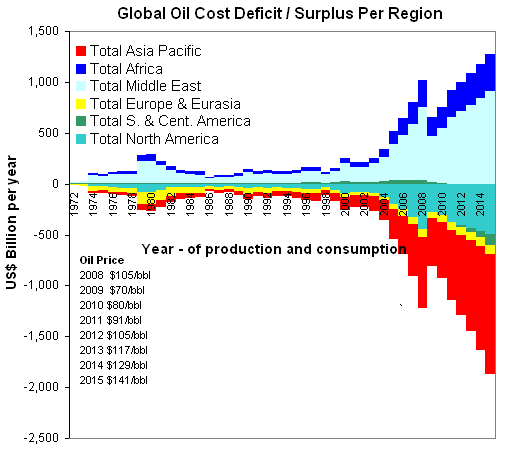
* This chart is meant to allow visitors to understand why certain regions and countries slip into recessions when oil prices rise.

